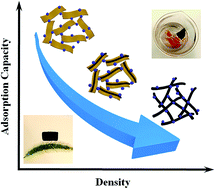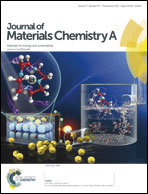Density controlled oil uptake and beyond: from carbon nanotubes to graphene nanoribbon aerogels†
Abstract
Large-scale manipulation of the density (from 2.5 to 1327 mg cm−3) and wettability of carbon-based aerogels has been realized by delicately modulating the gelation, drying and post-treatment processes. An unexpected “Janus face” effect of pyrrole was revealed in the fabrication process. Pyrrole acts as a “spacer” at relatively low concentrations (<ca. 5 vol%), resulting in a decrease of the aerogel density; however, “linker” behaviour appears at higher concentrations (>ca. 5 vol%), leading to an increase of the aerogel density. By using systematic studies, the oil adsorption capacity of aerogels has been correlated with the aerogel density and surface wettability, which can guide the production of highly efficient sorbents. For example, a polydimethylsiloxane modified graphene nanoribbons aerogel with a density of 2.5 mg cm−3 was prepared and showed a remarkable adsorption capacity of up to 302 times for phenixin and 121 times for n-hexane its own weight, much higher than that of most carbonaceous sorbents previously reported. Furthermore, a proof-of-concept aerogel-based floating-type densitometer has also been proposed to expand the potential applications of aerogels.


 Please wait while we load your content...
Please wait while we load your content...